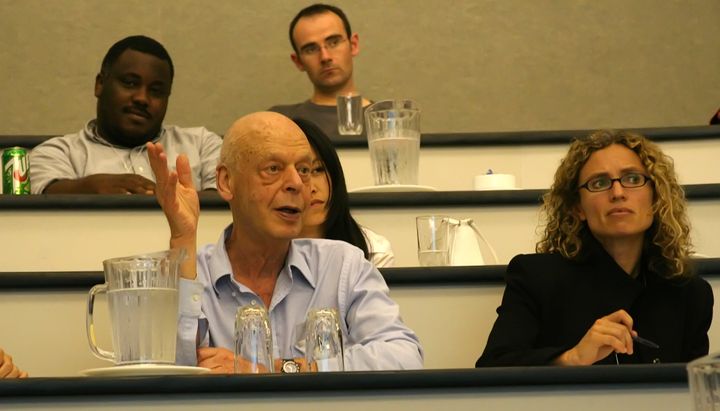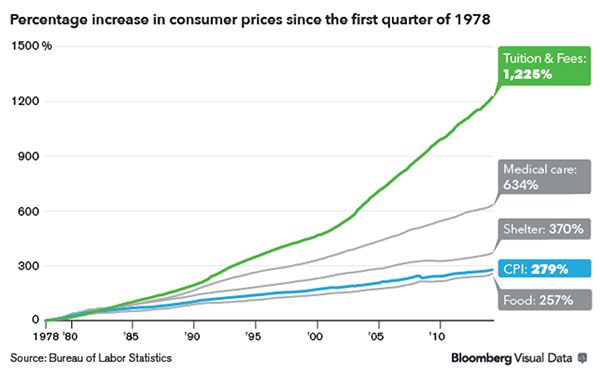
Economist William Baumol presenting his views at a conference in 2005.
But economists still argue over why U.S. is suffering from unique problem
Last month, a brilliant 95-year-old economist passed away. The New York Times, in a business article about his career, joked that he didn’t die from the affliction he had coined: cost disease.
While inefficiency plaguing the most important service sectors of our economy didn’t kill William Baumol on May 4, market failure threatens our society in existential ways.
Baumol’s fundamental insight was that the price for services like college tuition and concert performances -- due to labor intensiveness and lack of productivity gains -- becomes exponentially more expensive.
He illustrated how an orchestra playing Beethoven never really gets more efficient, because its work will always require more or less the same amount of time and energy. Since the musicians demand salaries sufficient to survive -- though the product does not become intrinsically more valuable -- their live music becomes disproportionately costly to experience.
Besides educational fees, the major areas of our economy experiencing such a “cost disease” phenomenon are medicine and infrastructure, in addition to other critical services, from garbage collection and police patrols to investment management.
“In the past fifty years, education costs have doubled, college costs have decupled, health insurance costs have decupled, subway costs have at least decupled,” writes blogger Scott Alexander in Slate Star Codex. “U.S. healthcare costs about four times as much as equivalent healthcare in other First World countries; U.S. subways cost about eight times as much as equivalent subways in other First World countries.”
In 1983, Baumol predicted that quality of life in America would progressively erode, as the truly meaningful things rise dramatically in price, even as mass-produced items -- whether high-tech toys or mere junk -- become more affordable. Food, clothing, and other regular stuff in the U.S. generally doesn’t get much more expensive.
The core observation by Baumol is that good, old-fashioned human contact remains the basic ingredient of so many major economic activities. While the digital revolution has altered many aspects of the environment in which services are procured and provided, much of the actual job function stays the same.
But it seems important to add the importance of four other factors in causing service price inflation, to construct an expanded, revised definition of American cost disease: information asymmetry (purchasers don’t know or care that they’re being ripped off); demographic factors (population pressure and increased demand from foreign consumers); socio-economic values (our embrace of the meritocratic principle of handsomely remunerating people at the top and our collective willingness to pay a premium for the best in class); and cultural reasons for the faltering American Dream (there’s not much ordinary citizens can do about rising inequality and a high cost of living that erodes the middle class).
Despite the coming automation of many occupations, cost disease means that prices in the following sectors will keep moving upwards:
Schooling the next generation
As Tyler Cowen wrote for Bloomberg on the eve of President Donald Trump’s inauguration, computing and communications advances don’t actually make teaching much better or cheaper. His context was articulating how governments responsible for subsidizing or boosting low-productivity-growth sectors, including education, see their burden balloon over time.
So the inherent fallibility of our species — the inability to learn faster and get educated more effortlessly — has put a limit on how much machines facilitate the process, whether primary, secondary, or beyond. Moreover, per-student spending outstrips improvement on standardized testing.
As the pool of eligible matriculants expands, the quantity of pupils desiring higher education pushes the cost of a decent degree further toward levels unaffordable for regular people. This occurs even as the rate of inflation for ordinary consumer goods rises slowly.

The cost of important services increased dramatically over the last few decades (not adjusted for inflation).
For a college student enrolled in 2015, the average projected cost of a 4-year degree at a private U.S. college, including tuition and fees, is $134,600. By 2033, this will climb to $323,900. Looking at the last decade, the annual rate of increase was around 5 percent, according to the College Board. Diplomas are becoming prohibitively pricey for a large chunk of the population. Irrespective of decreased government funding, the problem occurs both with public and private universities.
Perhaps if we Americans were easier to teach, online education would become more popular and truly compete with traditional learning environments. But the impact is constrained by our lack of discipline and the value placed on institutional status.
Going to college certainly adds to the lifetime earnings premium, but the cost has jumped disproportionately.
Healthcare for all
Overall, costs in this area of the economy went up 5.8 percent in 2015. That year, average inflation in the consumer price index was below 1 percent.
To be sure, the problem isn’t limited to the United States. There is globally prevalent growth in annual medical costs of over 9 percent.
However, the U.S. still spends way more per capita than comparable countries, with American consumers paying about twice as much as folks in Europe and Asia for the same outcomes. But our average life expectancy and health are worse in comparison. As with many human development indicators, the most affluent Americans are in excellent shape, while the median is truly falling behind.
So, is the solution more taxing and more spending? Or does that create more waste and thus stifle productivity growth? Ultimately more public intervention is probably necessary, yet there’s no political winner in an aging society where more and more voters want to retire with decent benefits.
If only homo sapiens could be healed more efficiently, then perhaps we wouldn’t be having this debate. Regardless, in spite of the explosion of health insurance costs, experts don’t agree on whether better health is a direct result. Much of the improvement over the decades has come from superior nutrition, sanitation, and medicine.
Infrastructure spending
Across the country, public transit advocates have long complained about the lack of money spent on fixing our existing transportation options and building new systems. Roads are falling apart, bridges collapsing, and airports reeling. Overall, the D+ state of American infrastructure is deplorable compared to similar economic powers.
Maybe it’s no wonder that we’re not doing enough maintenance and building when the price has spiraled out of control. Take the example of the New York City Subway. When built in 1900, the price of construction (in today’s dollars) is estimated to have been $100 million per kilometer. Today, that same length of subway costs $2.2 billion -- 22 times more.

Construction on the Second Avenue Subway's 86th St. cavern on January 21, 2014, in New York City.
Other industrialized countries can build subways at far lower prices. Even in old, dense places like Paris and Berlin, the cost is around $240 million. That’s ten times cheaper. It’s easy to blame unions or land-acquisition costs, but neither scapegoat seems to hold water.
Highway construction suffers from similarly bloated budgets, for a variety of somewhat opaque reasons that make the road network a “money sink.“ As for skyscrapers, remember that the Empire State Building went up in just over a year. Imagine that in 2017!
Vox’s Matthew Yglesias suggests that transit advocates should pay more attention to cost disease within this sector, to expedite more projects. Optimists point to Trump’s $1 trillion plan to energize the economy through infrastructure projects, but the proposal is still in its early stages.
Investment management
Another area lacking in cost discipline is financial services. Noah Smith writes how “active management” of clients’ funds has snatched up a significant portion of Americans’ retirement accounts. A few economists argue that financial intermediaries have become less efficient over time.
Some investment professionals themselves are even saying they may be earning more than their fair share of market returns, by not encouraging future retirees to invest in low-cost index funds. Instead the clients get hit by a variety of fees on managed funds: for transactions, “distribution,” and other miscellaneous charges.
Studies show that financial advisors often urge customers away from investments that wouldn’t make the managers as much money. There’s often encouragement to direct investment into structures that share upfront fees. However, the Fiduciary Rule that took effect this month should help to rein in costs around retirement advice.
Yet critics say advisory fees could rise as firms face increased compliance and liability costs. Regardless, many comparable societies have much more regulation and government intervention.
‘Less and less for their money’
Smith goes on to argue that the problem is not bigger or smaller government, but a government that neglects to cut costs in “overgrown sectors of the economy.”
The solution, he says, is for government to employ a “cost-control” strategy: capping student loans at a certain amount to discourage colleges from raising tuition just to earn more funds; Congress letting Medicare arrange lower healthcare and drug prices; agencies using more leverage in the contracting process to keep expenses down for infrastructure projects; and continuing to strengthen capital requirements on big banks, thereby dis-incentivizing riskier investments and minimizing costs for everyday investors.
“Costs are high due to general inefficiency -- inefficient project management, an inefficient government contracting process, and inefficient regulation,” says Smith, in an article focusing on infrastructure. “It suggests that construction, like healthcare or asset management or education, is an area where Americans have simply ponied up more and more cash over the years while ignoring the fact that they were getting less and less for their money.”
So, we are left to wonder why, in addition to Baumol’s main observation about lack of productivity growth, all of these sectors in the U.S. economy are so dysfunctional. Lots of advanced economies have similar productivity issues, but the U.S has an exceptional problem. Let’s take a step back and look at the other big-picture explanations, because none of these separate but interlocking puzzles has an easy solution.
Superficially, our economy is doing just fine. GDP growth numbers are okay, unemployment low, consumer confidence robust, and inflation in check. However, in real terms, it’s hard to argue that most Americans are becoming better off.
Hoarding the American Dream
One major culprit in rising service costs is termed “bad information,” which often arises from the lack of transparency or sheer miseducation on important financial concepts. This is the central component of an argument made in the new book “Phishing for Phools: The Economics of Manipulation and Deception” by economists George A. Akerlof and Robert J. Shiller.
People get ripped off either because they don’t know any better or understand how much things should cost. The implication is that many of us are ignorant suckers. The core economic precept is that X costs Y because that’s how much people will pay for it; the market doesn’t mind consumers being gauged. Their analysis captures the good and bad of capitalism, while proposing reform, regulation, and greater financial literacy as the best fixes.
Another explanation is that, besides our domestic population being bigger than ever, there’s way larger external demand for these “Made in the USA” services -- and thus upward pressure when the supply doesn’t keep pace. This applies to Chinese students seeking Ivy League degrees, Gulf nationals shopping for the best medical care, or Russians buying up luxury apartments in Manhattan. In a globalized and interconnected world, the finest American services carry significant cachet for those willing and able to pay. This is a result of reputation, branding, and quality for crème-de-la-crème attention at Harvard University or Johns Hopkins Hospital.
A third factor worth strongly considering is the culture of rewarding those at the top with hefty salaries, and thus, accumulation of wealth over time. As a society, we’ve settled on a compensation setup whereby many doctors, lawyers, and merchant chiefs command high pay relative to their counterparts in other nations. While the upper-middle class is thriving in America, many hard-working teachers and nurses clearly don’t fall into this category.
In such a service-oriented economy, considerably higher personal incomes for those with advanced educations and good jobs come, to a certain extent, at the expense of the masses. A recent book by economist Richard Reeves called “Dream Hoarders” articulates how rising inequality has limited the American Dream to the 20 percent at the apex of the class hierarchy.
With home prices surging in many big metro areas and across the country, socioeconomic mobility appears blocked; we have become a fractured society where opportunity is being “hoarded” by the top quintile. Legacy admissions, exclusionary zoning, and tax privileges are among the ways this system is kept intact.
The bottom line is that the cost of paying for the most basic and important services is going up way faster than are wages. There are a million and one reasons we could cite. Perhaps the reality is not that economies of scale become too big to fail but that they’re in fact too big to be efficient for those who most need the market’s help.
As Baumol predicted, cost disease is only getting worse. But we should do everything we can to treat our chronic economic condition.
